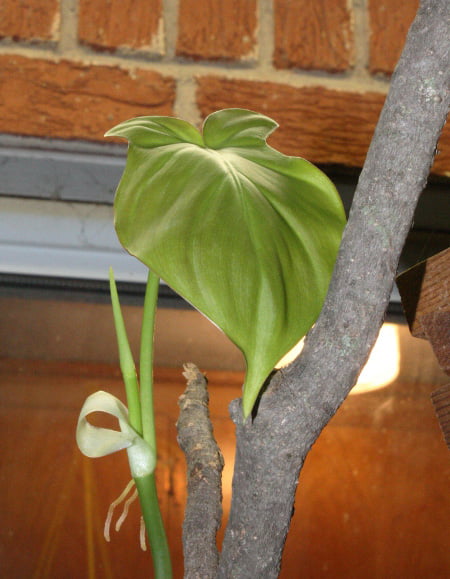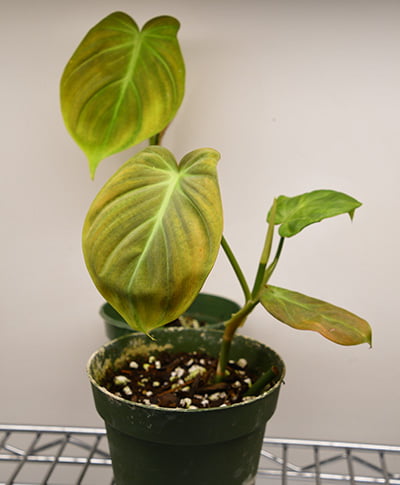Philodendron Camposportoanum is a stunning and rare plant that indoor garden enthusiasts highly prize. This plant is native to Brazil and features large, glossy leaves marked with distinct, vibrant green and yellow variegation. The striking foliage of this plant is the perfect way to add a touch of tropical flair to your home or office. Not only is Philodendron Camposportoanum beautiful, but it is also relatively easy to care for, making it a great choice for both beginner and experienced plant owners alike.
Below, we'll tell you everything you need to know about Philodendron Camposportoanum care. With the right care, this plant can thrive and bring joy and beauty to any space it inhabits.
What Is Philodendron Camposportoanum?
The Philodendron Camposportoanum plant is one of the easiest Philodendron plants to care for. A tropical plant of the Philodendron species, this plant is native to Central and South America, where it grows beneath the rainforest canopy. Philodendron Campos is a non-climbing Philodendron planting, happily growing on the rainforest floor. It grows to about 25 inches tall when kept as a houseplant and needs moderate support from a moss pole. They also grow well in a hanging plant pot.
One of the unique characteristics of the Philodendron Camposportoanum plant is that its leaves change appearance dramatically as it grows. New leaves emerge velvety and dark, and the juvenile leaves develop long dramatic back lobes and take on a heart shape. As the plant matures, the heart-shaped leaves start to resemble the triangular "hammer" leaves common to Philodendrons. The leaves also develop an orange, peach coloring, particularly noticeable in the sunlight. A single Philodendron Camposportoanum plant may have all three types of leaf color and shapes simultaneously!
Philodendron Camposportoanum Care Requirements
Light
Like other tropical plants, Philodendron Campos needs lots of bright, indirect light. It's important to avoid direct sunlight, as this plant would typically receive bright light filtered through the canopy of rainforest trees, and direct sunlight can cause the leaves to turn yellow or scorch. Place your Philodendron Camposportoanum in a north or east-facing window, where it will receive plenty of bright, indirect sunlight.
Water
Philodendron Camposportoanum requires a bit more watering than other Philodendron varieties. It's important to keep the soil moist, and your plant hydrated, but also avoid over-watering. To achieve this, always use your finger to check the top of the soil - just the top layer, not the top couple of inches!
If the soil is moist, wait another day or two before watering. If the soil is dry, water it thoroughly until the excess water comes out of the drainage holes.
Temperature
This tropical plant likes a warm environment, between 55 and 80 degrees Fahrenheit. It does not tolerate frost or cold temperatures, so if you're growing your Philodendron Campos outdoors, bring it inside when nighttime temperatures drop below 50 degrees Fahrenheit.
Humidity
The Philodendron Camposportoanum plant grows best in a high-humidity environment. Low humidity won't damage a healthy plant, but it won't grow its best either. You will likely need to increase the moisture in the air around your plant, as your house humidity level probably doesn't rival a rainforest! Here are some ways to do this:
Pebble Tray
Place pebbles in a tray, then fill the tray with water. Take care that the water does not come up over the top of the pebbles! Set your plant pot on top of the pebbles. As the water evaporates, it increases the air moisture around the plant.
Group Plants Together
Plants naturally increase the humidity of the space around them. By placing humidity-loving plants together, they will work to boost the nearby air moisture.
Misting
Mist the leaves of your Philodendron Camposportoanum regularly.
Soil
It's important to place your Philodendron plant in a pot filled with slightly acidic, well-draining soil. It's important to create a soil mix that holds onto water and allows excess water to pass through. The great potting soil recipe for this plant is to start with any of the porous potting soil mixes, then add in sphagnum peat moss (for moisture retention) and perlite, vermiculite, sand, or shredded bark (for aeration).
Fertilization
During the growing season of early spring through late summer, applying a slow-release fertilizer each month is recommended. Choose a balanced fertilizer and dilute it to half-strength before applying it.
Pruning
Pruning Philodendron Camposportoanum is a relatively simple process that can help keep the plant looking healthy and attractive. Generally, it's a good idea to prune Philodendron Camposportoanum in the spring or summer when it is actively growing. Avoid pruning during the winter or fall, when the plant may be in a dormant phase.
Identify which stems or leaves you want to remove. Pruning can be used to remove dead, damaged, or diseased foliage and control the size and shape of the plant. Use a pair of clean, sharp pruning shears to make a clean cut at the base of the stem or leaf you want to remove. It's important to make a clean cut to avoid damaging the surrounding tissue. If you are pruning to control the size of the plant, you may want to consider training it to climb support or trellis. This can help the plant grow in a more vertical, space-saving manner.

Source: Flickr
Propagation
Propagate Through Stem
The easiest way to propagate Philodendron Camposportoanum is through stem cuttings. Here's how:
Use clear garden shears to cut a three-inch length of the stem. Cut right below a leaf note, and be sure that the cutting has at least two healthy leaves.
Allow the stem cutting to "cure" for a week in a warm environment. This lets the cut end callously over.
Dip the stem cutting in rooting hormone, then plant it in a pot filled with well-draining soil. Place the pot in a warm location with bright, indirect light. You can put a plastic bag over the top of the pot for a while to help trap humidity.
Roots will establish in a few weeks!
Propagate Through Air Layering
You can also propagate Philodendron Camposportoanum through air-layering.
Use a clean knife to make a two-inch cut down a healthy stem near a leaf node.
Use a toothpick to keep the cut open, if necessary, then wrap the cut with moist sphagnum moss.
Wrap plastic wrap around the moss, wound, and stem. Wrap tightly enough that the moss stays around the wound but not so tightly that air can't move.
You should see roots growing out of the wound in about three weeks. When the plant's roots are four inches long, cut the stem away from the rest of the plant, and plant it in a pot filled with good soil.
Propagation through Division
If your Philodendron Camposportoanum has several stems growing together, it can be divided into multiple plants. Carefully remove the plant from its pot and gently separate the stems, making sure each division has its own roots. Repot each division into its own pot with fresh soil.
Repotting
Repotting Philodendron Camposportoanum is a fairly straightforward process. Here are the steps you should follow:
Choose a pot that is one size larger than the current pot. Make sure it has drainage holes at the bottom.
Prepare a well-draining potting mix. A good mix for Philodendron Camposportoanum can include peat moss, perlite, and coarse sand.
Water the plant a day or two before you plan to repot it. This will help the soil hold together better during the repotting process.
Carefully remove the plant from its current pot. You can do this by gently tipping the pot and gently pulling on the base of the stem.
Gently loosen any tangled roots and remove any dead or rotting ones.
Place a layer of fresh potting mix in the bottom of the new pot. Set the plant in the center of the pot and add more potting mix around the sides, gently pressing it down to eliminate any air pockets.
Water the plant thoroughly until water drains from the bottom of the pot. You can also add a layer of mulch or a top dressing to help retain moisture.
Place the plant in a bright, indirect light location and avoid direct sunlight.

Source: Flickr
Common Problems With Philodendron Camposportoanum
Philodendron Camposportoanum is a pretty easy houseplant to care for, but you might still come across a few problems.
Common Pests
Spider mites, mealybugs, and scale may come to make a meal of your Philodendron. You can treat infestations of both by spraying the plant down with neem oil.
Common Diseases
Overwatering can lead to root rot. You can prevent root rot by always checking the soil moisture before watering your plant and only using pots with drainage holes. Ceramic pots can also help wick away excess moisture. If your Philodendron Campos has root rot, unpot it, cut away the rotten roots, then replant it with fresh soil.
Troubleshoot Philodendron Camposportoanum
Yellowing leaves
If the leaves are turning yellow, it may be a sign of overwatering or underwatering. Ensure you do not water the plant too frequently or allow the soil to dry out completely.
Brown tips on leaves
Brown tips can indicate either over-fertilization, underwatering, or low humidity. Check your watering and fertilization schedule, and consider adding a humidifier or placing a tray of water near the plant to increase humidity levels.
Brown Leaves
Brown leaves can be a sign of too much sunlight or low humidity. If this occurs, ensure your plant is receiving indirect sunlight and is receiving high humidity.
Pests
Philodendron Camposportoanum can be susceptible to common houseplant pests like spider mites, mealybugs, and scale. If you notice any signs of infestation, such as webbing or sticky residue on the leaves, treat the plant with an appropriate insecticide or insecticidal soap.
Root rot
Overwatering can lead to root rot, which can cause the plant to wilt and die. If you suspect root rot, remove the plant from its pot and examine the roots. If they appear brown, mushy, or foul-smelling, cut away the damaged roots and repot the plant in fresh soil.
Stunted growth
If the plant is not growing as expected, it may be due to insufficient light or nutrients. Ensure that the plant is getting enough bright, indirect light, and consider adding a balanced fertilizer to the soil to promote healthy growth.
Is Philodendron Camposportoanum Pet Friendly?
No, Philodendron Campos is not pet-friendly. All parts of this plant contain high amounts of calcium oxalate crystals, which are toxic to animals if ingested. These crystals can cause irritation, swelling, and pain in the mouth, tongue, and throat leading to difficulty swallowing, vomiting, and other digestive issues.
It's important to keep plants like Philodendron Camposportoanum out of reach of pets to prevent accidental ingestion. If you suspect your pet has ingested any part of this plant, contact your veterinarian immediately for guidance on how to proceed.
